How is Windows Vista Service Pack 1 running?
Microsoft on Friday made available to the public a pre-release version of Windows Vista SP1. We want to know what you think, assuming you're willing to install the beta.
Service Pack 1 -- due out this quarter -- is slated to bring a number of major improvements to Microsoft's flagship operating system, but mostly behind the scenes. Performance and reliability has been boosted, in addition to improved compatibility with applications and drivers. Vista users have been clamoring for SP1 since the OS debuted one year ago, so we want to know: does it live up to the hype? Leave a comment below with your experiences, both good and bad.
Toshiba drops price of HD DVD players as format war continues
In a sign the high-definition format war is far from over, Toshiba on Monday dropped the suggested retail price of its entry-level HD DVD player to under $150. That puts the HD-A3 $250 cheaper than Sony's PlayStation 3.
The MSRP of the HD-A3 will now be $149.99 USD, while the HD-A30 with 1080p output is lowered to $199.99 USD. Toshiba's high-end HD-A35 will now be priced at $299.99 USD. Retailers are already undercutting these prices, with Amazon selling the A3 for just $134.99, while TigerDirect has it listed for $129.99.
CES 2008 'Better Questions' contest winners
After culling through over 300 entries, we have selected the best questions from our CES contest and attempted to find the answers. Winners will be contacted via e-mail next week regarding their prize.
Without further ado, in no particular order:
XStreamHD is the real deal, but challenges lie ahead
Instead of taking a cursory peek at XStreamHD and writing it off, we actually sat down with the company's CEO to dig deep into the new satellite-based video delivery service.
On display for the first time at CES but in development since 2002, XStreamHD sees itself as a "transport network" for content providers. The platform is built on a simple premise: the Internet isn't fast enough to do broad distribution of high-definition video and existing hardware boxes like TiVo aren't able to handle full 1080p HD.

Up Close: Kaleidescape's high-end media servers
Kaleidescape is a name few consumers have heard, and probably for good reason: its home media servers start at $5,000 and reach upwards of $100,000. But the company had its wares on display at CES and we took a gander at the hardware and its user interface.
The Kaleidescape system works well; the UI is fast and it's surprisingly easy to navigate and load up a full library of content, whether audio, video or other. In addition, only one server is required per home, while movie and music players simply relay content to other rooms. But is it worth 20 times (or more) the cost of a TiVo or DivX Connected device? Only for a very select few.
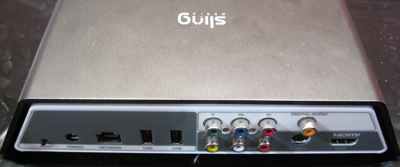
Sling Media shows off new hardware, software player
Sling Media continues to grow its catalog of Slingbox hardware, this week adding a model that can stream content in HD and a new device called the SlingCatcher.
The Slingbox is a piece of hardware that connects to your television and Internet connection in order to let you view and control your TV from wherever you are. Programs are streamed to the SlingPlayer software and quality is adjusted depending on connection speed.
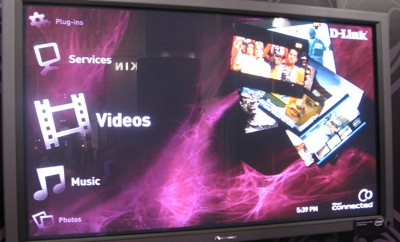
Up Close: D-Link's DivX Connected device
Before the CES show floor closed for the year, we got some face time with D-Link's DivX Connected device, which as the name suggests, is a display extender for DivX content. The device has been available in parts of Europe since November and will ship in the US before the summer with a price of "under $250."
DivX has long had its codecs integrated into DVD players and other consumer electronics devices, but the DivX Connected platform is different. The company has developed the software and handled the hardware design itself through a partner ODM. That means manufacturers such as D-Link can easily put a DivX Connected device on the market.

AMD shows off its Puma platform beating Centrino
Although AMD didn't have a major presence at CES, the chipmaker did have a reference design of its upcoming Puma platform on hand to show how it out-performs Intel's Centrino platform.
Puma is essentially the company's new "Griffin" processor paired with an ATI graphics chipset and designed for laptops. It also adds a chip dedicated for high-definition video that sits right on the GPU. The platform will be the first to support DirectX 10.1 in a mobile environment.
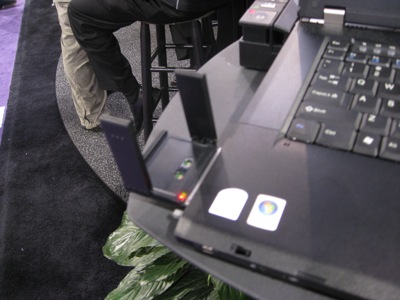
Up Close: Sprint's Xohm WiMAX card
Sprint had a dedicated Xohm booth at CES to showcase it's upcoming WiMAX service, which is expected to launch in a few markets this April. Xohm is already being tested by Sprint employees in three cities. Here's what the laptop cards look like.

Up Close: Asus Eee notebooks and mobile phones
Asus, a fairly new entrant to the notebook market, was showing off its 8-inch Eee at CES this week. Oddly named, the Eee was introduced last June and will soon go on sale at Costco in the United States. Although it can run both Linux and Windows XP, the Eee will ship out of the box with Linux for an estimated $199.
The Eee has a 900Mhz Intel processor, 512MB of RAM, 802.11g Wi-Fi, and 4GB of flash storage. An 8GB model is available for $299. Asus' notebook largely falls in the same product category as the OLPC laptop, but is not targeted at emerging markets.
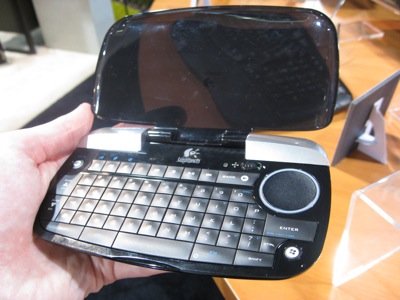
Up Close: Logitech's new diNovo Mini keyboard
Logitech has the answer for those computer users with a media center PC in their living room that want to avoid keeping a big keyboard on their coffee table. The company's new diNovo Mini keyboard, introduced at CES, is about the size of a cell phone and includes a trackpad for moving the mouse that detects taps for clicking.
The design is fairly solid if not a bit plasticky, and its clamshell-like design protects the diNovo Mini from spilled drinks and being dropped on the floor. But the unique keyboard won't come cheap, with retail availability slated for February at $149 USD.
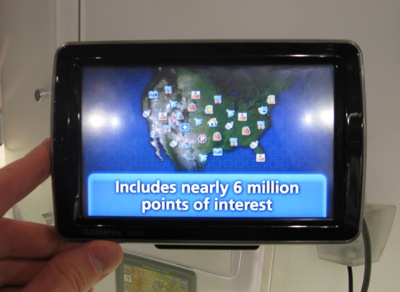
Up Close: Nuvi's new GPS line up
We stopped by the Garmin booth in the CES South Hall to get some hands-on time with the new GPS devices the company announced this week. Garmin's Nuvi 780, 880, and 5000 with MSN Direct will be released in the spring. The 5000 was far more hefty than the others, and will cost $800.
Nuvi 5000
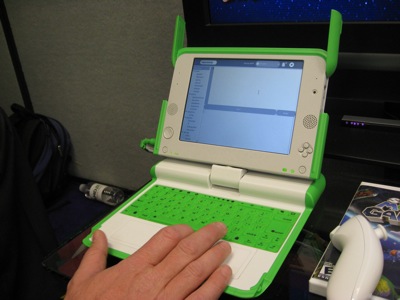
Up Close: The OLPC $188 laptop
AMD had an OLPC laptop on hand to showcase the fact that its Geode processor powers the device designed for emerging markets. Navigating via the symbol-based interface proved difficult at first, but the laptop was solidly built and easy to use. We managed to take a picture with the built-in camera and share it, although the laptop became quite sluggish -- almost unusable -- when many applications were launched.

Blu-ray goes interactive for 2008, but will consumers bite?
With Blu-ray Profile 2.0 bringing Internet connectivity to all future players, the format is looking at interactivity to convince customers to make the switch. Blu-ray's focus on interactive features is also a response to HD DVD, which has long offered advanced Web-enabled capabilities through the format's HDi layer.
"Now we're ready for the next phase: the phase to really fulfill the promise of Blu-ray technology. That's really to start to develop the interactivity," said David Bishop, President Worldwide for Sony Pictures Home Entertainment, during Monday's Blu-ray press conference. "We'll really get the chance to use our creative juices moving forward. You'll see multiplayer gaming, ringtones that can be delivered to the consumer."

Up Close: Hitachi's 1.5-inch thin LCD displays
While Panasonic went even bigger with its 150-inch plasma TV, Hitachi went small, showcasing a lineup of 1.5-inch thick LCDs. An 11-foot wide plasma may impress, but consumers can actually take advantage of Hitachi's ultra-thin displays.
The theme of this year's CES is shaping up to be one of design rather than power. Pioneer and Panasonic are also showing off ultra-thin displays, but only Hitachi's will go one sale in the near future in 32-inch, 37-inch and 42-inch sizes.

